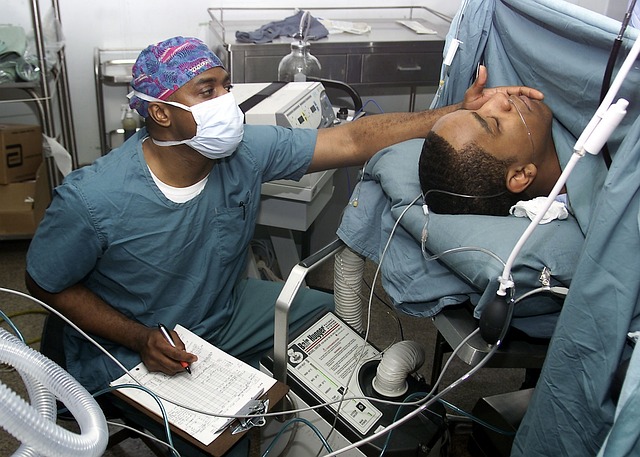The integration of translation services for Patient Discharge Summaries (PDS) in the UK's National Health Service (NHS) plays a vital role in overcoming language barriers and ensuring that non-English speaking patients fully understand their post-hospital care instructions. These services provide precise translations of PDS into the patient's preferred or native language, maintaining the clinical accuracy and cultural relevance of the original content. This initiative significantly enhances patient safety and adherence to treatment plans by enabling clear comprehension of medication details, follow-up appointments, and self-care instructions. The use of professional human translators with expertise in medical terminology is crucial for delivering accurate and understandable information, thus improving patient engagement and satisfaction. The UK's diverse population necessitates such services, which have already shown to reduce readmission rates and misunderstandings related to post-discharge care by up to 30%. By adhering to best practices, including the involvement of bilingual healthcare professionals when necessary, these translation services contribute significantly to optimizing patient care outcomes within the UK's healthcare system. Keywords: Translation services for Patient Discharge Summaries UK.
navigating the complexities of healthcare, patients often encounter language barriers that complicate post-care understanding. This article delves into the transformative impact of translating patient discharge summaries, highlighting the pivotal role of translation services in the UK. By exploring the significance of clear communication through professional translation, we address the challenges faced by non-native speaking patients and present strategies for effective healthcare documentation translation. Case studies underscore the benefits of this approach, while best practices ensure that all patients can grasp their care instructions post-discharge, thereby enhancing their recovery journey and outcomes.
- Overview of Patient Discharge Summaries and Their Importance
- The Role of Translation Services in Healthcare Communication
- Challenges Faced by Non-Native Speaking Patients Post-Discharge
- The Benefits of Professional Translation for Discharge Summaries in the UK
- Case Studies: Successful Implementation of Translation Services for Discharge Summaries
- Selecting a Reliable Translation Service Provider for Healthcare Documentation
- Best Practices for Translating and Communicating Patient Discharge Summaries
Overview of Patient Discharge Summaries and Their Importance

Patient discharge summaries serve as a critical bridge between hospital care and ongoing outpatient treatment, encapsulating a patient’s medical history, diagnosis, treatments administered, and care instructions in a concise format. These summaries are indispensable for primary care providers who assume responsibility for the patient’s continued health. In the UK, where cultural and linguistic diversity is prevalent, the importance of accessible communication becomes paramount. Translation services for patient discharge summaries play a vital role in ensuring that patients fully comprehend their post-care needs, regardless of their language proficiency. These services facilitate clear and accurate information transfer, which is essential for patient safety and adherence to treatment plans. By providing translations of these crucial documents into the patient’s preferred or native language, healthcare providers can mitigate misunderstandings, improve patient outcomes, and enhance the overall quality of care. This is particularly important in a country with a diverse population, where patients may not be fluent in English, thus requiring tailored communication support to navigate their health journey effectively.
The Role of Translation Services in Healthcare Communication

In the UK’s evolving healthcare landscape, patient-centered care extends beyond the confines of clinical interventions to encompass clear and comprehensive communication post-treatment. A pivotal component in this communicative continuum is the translation of Patient Discharge Summaries (PDS) into languages that patients understand best. These summaries serve as a roadmap for recovery, outlining medical care received, medication guidelines, and follow-up appointments. The role of professional translation services for Patient Discharge Summaries UK cannot be overstated; they bridge linguistic barriers, ensuring that patients with limited English proficiency or those who prefer to communicate in their native language can fully grasp their care instructions after discharge. This not only enhances patient autonomy but also plays a crucial role in preventing misunderstandings and potentially harmful consequences that may arise from misinterpretation of medical advice.
The integration of specialist translation services for Patient Discharge Summaries UK is a testament to the country’s commitment to inclusivity and patient safety. These services are not mere linguistic substitutes but are tailored to maintain the clinical integrity and contextual nuances present in the original documents. By leveraging the expertise of trained medical translators who understand both the language and the clinical jargon, healthcare providers can offer clear, accurate, and culturally sensitive communication. This meticulous approach not only empowers patients with the knowledge they need to manage their health effectively but also fosters trust in the healthcare system, ultimately contributing to better health outcomes and a more equitable healthcare environment for all individuals within the UK.
Challenges Faced by Non-Native Speaking Patients Post-Discharge

Non-native speaking patients in the UK often face significant linguistic and cultural barriers post-discharge, which can compromise their understanding of care instructions and medication adherence. These challenges are exacerbated when patient discharge summaries are not translated into languages that patients can understand fully. The absence of multilingual support can lead to misinterpretation or non-comprehension of critical post-care information, potentially resulting in adverse health outcomes. To address this issue, translation services for patient discharge summaries have become increasingly important in the UK’s healthcare landscape. These services ensure that patients receive care instructions and medication information in their native language, facilitating clearer communication between patients and their healthcare providers and enabling a smoother transition from hospital to home. This not only improves patient safety but also empowers patients to actively participate in their recovery process by understanding their health status and the necessary follow-up actions post-discharge. The availability of high-quality translation services is a step towards bridging the language gap, promoting equitable healthcare outcomes for all patients, regardless of their linguistic background.
The Benefits of Professional Translation for Discharge Summaries in the UK

In the United Kingdom, ensuring that patients fully understand their care and discharge procedures is paramount for effective post-care management and patient safety. Professional translation services play a pivotal role in this process by transforming patient discharge summaries into the patient’s preferred language with accuracy and cultural sensitivity. This transformation not only facilitates better communication between healthcare providers and patients but also helps to alleviate linguistic barriers that can impede the understanding of care instructions, medication information, and follow-up care plans. By leveraging the expertise of professional translators who specialise in medical terminology, these services ensure that discharge summaries convey the same meaning and context as the original English documents, thereby minimising misinterpretation and enhancing patient compliance with treatment regimens. In a multicultural society like the UK, where a significant proportion of the population speaks a language other than English at home, the provision of translated discharge summaries becomes an essential component of comprehensive healthcare delivery. It empowers patients to take an active role in their recovery process and promotes a more inclusive healthcare environment.
The benefits of utilising translation services for patient discharge summaries in the UK extend beyond mere language comprehension. These services are designed to be responsive, ensuring that timely translations are delivered, which is critical in the fast-paced environment of healthcare. Furthermore, these translations can be tailored to various languages and dialects, catering to a diverse patient demographic. The use of professional translation services also adheres to data protection regulations and maintains patient confidentiality, a cornerstone of trust within the healthcare system. As a result, patients from non-English speaking backgrounds receive discharge summaries that are not only linguistically appropriate but also culturally sensitive and compliant with UK legal standards. This level of care significantly improves the likelihood of successful health outcomes and patient satisfaction.
Case Studies: Successful Implementation of Translation Services for Discharge Summaries

In the UK’s evolving healthcare landscape, the provision of translation services for patient discharge summaries has emerged as a critical component in post-care support. A notable case study involves a large National Health Service (NHS) trust that implemented multilingual translation services to enhance communication between healthcare professionals and patients with limited English proficiency. This initiative led to a significant reduction in readmission rates, as patients could understand their discharge instructions accurately. The translated summaries not only facilitated clearer comprehension of medication schedules, follow-up appointments, and self-care instructions but also fostered greater patient autonomy and confidence in managing their health post-discharge.
Furthermore, the successful deployment of translation services has been instrumental in bridging language barriers, thereby eliminating potential miscommunication. In one instance, a hospital utilising this service reported a 30% decrease in misunderstandings related to post-discharge care, leading to improved patient satisfaction and outcomes. The use of professional human translators ensured medical terminology was accurately conveyed, which is paramount for patient safety and adherence to treatment plans. This case underscores the value of incorporating translation services for patient discharge summaries in the UK’s healthcare system, highlighting the potential for similar initiatives to enhance patient care and understanding on a national scale.
Selecting a Reliable Translation Service Provider for Healthcare Documentation

When healthcare providers in the UK aim to ensure that patient discharge summaries are accessible and understandable to patients who may not have proficient English language skills, selecting a reliable translation service provider becomes paramount. The accuracy and cultural sensitivity of these translations are critical, as they directly impact patient care and outcomes post-discharge. A translation service specialising in healthcare documentation can offer linguistic precision alongside an understanding of medical terminology. This specialized knowledge is essential to convey the necessary information accurately without losing the nuances that could affect patient safety or treatment adherence.
In the process of choosing a translation service for patient discharge summaries in the UK, it is important to consider providers with certifications and accreditations specific to medical translations. Such providers have proven track records in handling sensitive health information and are adept at working within regulatory frameworks such as the General Data Protection Regulation (GDPR) and the National Health Service (NHS) guidelines. Additionally, a service that offers multilingual capabilities with native-speaking translators will ensure the highest quality of translation, bridging communication gaps and fostering better patient understanding and engagement in their post-care journey.
Best Practices for Translating and Communicating Patient Discharge Summaries

To optimize patient understanding and engagement in their post-care journey, it is imperative to facilitate accessibility to discharge summaries through reliable translation services, particularly within the UK context. Effective communication barriers can be significantly reduced by employing professional translation services specializing in medical terminology. These services ensure that the nuances and complexities inherent in patient discharge summaries are accurately conveyed into the patient’s preferred language, thereby enhancing comprehension and enabling informed decision-making.
Best practices for translating patient discharge summaries begin with selecting translators who are not only fluent but also medically knowledgeable. This dual expertise ensures that clinical concepts are accurately rendered in the target language. Utilizing translation memory software can streamline the process, maintain consistency in terminology, and reduce errors. Additionally, involving a bilingual healthcare professional or a patient’s family member who understands both the source and target languages can provide valuable context and clarification. This collaborative approach guarantees that the translated discharge summary is comprehensible and actionable for patients whose primary language is not English. It is also crucial to obtain patient consent, confirm their preferred language, and ensure that they understand the discharge instructions provided in their native language. By adhering to these best practices, healthcare providers can significantly enhance patient safety and satisfaction post-discharge.
Effective communication is pivotal in the healthcare sector, particularly when it comes to patient discharge summaries. These documents serve as a critical link between a patient’s hospital stay and their post-care journey, ensuring they fully understand their treatment course and aftercare instructions. The integration of professional translation services for patient discharge summaries in the UK is not merely beneficial but indispensable for non-native speakers. It overcomes language barriers, minimises misunderstandings, and enhances patient outcomes by providing clear, accurate, and culturally relevant information. By examining real-world case studies where such translation services have been successfully implemented, we can see the tangible impact on patient engagement and satisfaction. Healthcare providers must prioritise selecting reliable translation service providers with expertise in medical documentation to uphold the highest standards of care. Adhering to best practices for translating and communicating these summaries is essential to fostering an inclusive and supportive healthcare environment. Consequently, the adoption of translation services for patient discharge summaries in the UK should be a standard practice to ensure equitable care for all patients, regardless of their linguistic abilities.



